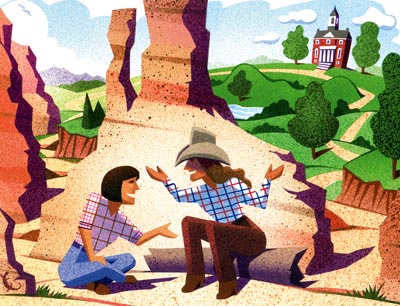Place in the heart
 I live in Moab, Utah, a rural town of about 5,000 where the longtime industries — ranching, then uranium mining — once guaranteed its isolation.
I live in Moab, Utah, a rural town of about 5,000 where the longtime industries — ranching, then uranium mining — once guaranteed its isolation.
Those activities have waned, and now, thanks to a tourism boom, the place attracts a lot more people. There’s world-class mountain biking, whitewater rafting on the Colorado River, two national parks, and, as a result, an ever-increasing number of coffee shops and Mexican restaurants. Still, the nearest mall and big-box stores are 90-plus minutes away, and first-run movies take a month to find our tiny three-screen theater. The local newspaper is just a weekly.
In this amazing landscape (lots of films have been shot around here), accented by a quirky, tight-knit community of locals, I’ve found my home. But living here has its tradeoffs, the most apparent of which is a disconnection from part of my identity — my Bates identity. Where I live, folks don’t just ask, “Where’s Bates College?” but “Where’s Maine?”
Bates itself is 2,000 miles away, and my closest college friends live in the Pacific Northwest or New England. Attending Bates weddings and visiting other friends during my travels helps me get a fix on my Bates identity, as do the e-mail BatesNews updates. A Bates calendar hangs in my home office.
Even as I’m feeling cut off from the place and people that helped form part of my self, my work here is all about place. My job with the Bioregional Outdoor Education Project helps rural schoolteachers instill in their students a stronger sense of place. The idea is that students who have a relationship with their outdoor place will become better citizens, more inclined to protect and interact with their environment.
On one summer trip to train teachers in outdoor education, I met a woman about my age. As we camped in the bean fields of eastern Utah and talked about our backgrounds, I learned that she was from New England. I peppered her with questions: What part? Was she familiar with the New England colleges?
Well, she wasn’t just familiar with the New England colleges. She was a Bates alumna — Sarah Merrill Strouthopoulos, Class of 1996.
My class. But we never knew one another as students.
It seemed impossible. But as she and I recreated our Bates years, we realized that we had led parallel and separate Bates lives. Sarah was an art history major; I toiled in the geology labs. She lived off campus; I was a happy Frye Street resident. She spent her junior year abroad in Nepal, while I spent a semester in Ecuador. She was a varsity skier, and I played rugby.
After that surprise mini-reunion, Sarah and I continued to work together during the school year. She is an elementary school teacher in Durango, Colo., about three hours from my home office in Moab. Every other week, I traveled to her classroom to work with her and her students. We set up compass courses in her schoolyard, conducted “Animal Olympics” with her students and their parents, and planned field trips throughout the year.
Sarah and I spent a rich school year reliving our time at Bates, but we also created a new chapter: us working together on outdoor and place-based education projects, while her students’ wide eyes told us we were accomplishing our goals. To our shared stories of Bates — we laughed about the housing lottery and recalled our graduation speaker — we added new ones, like her students’ highly amusing oral reports on Colorado eco-zones.
The teacher certification program culminates with an extended backcountry rafting trip on the San Juan River. Winding through southern Utah and the northern Navajo Reservation, Sarah and I realized that we had discovered a new sense of place, but not in strict geographical terms. Instead, it’s more like a deep awareness, one that was planted and grown in each of us during our Bates years, when we learned to take risks, challenge ourselves, and meet new people.
Separately, Sarah and I put down roots here in the West, drawn by a love of the landscape, the environment, and the people. But she and I are connected, and we are connected to others, across miles, across years, and across differences.
By Erika Jones ’96, Illustration by Marty Braun


